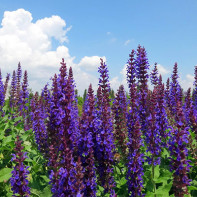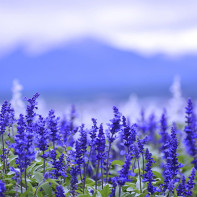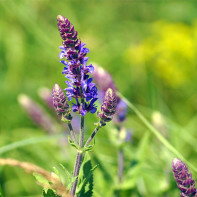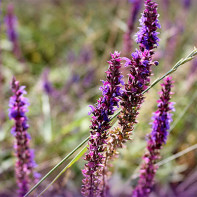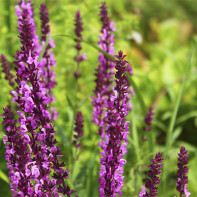Sage: medicinal properties and contraindications
The powerful and healing power of nature has long been known. For millennia, she generously shares her strength with people, helping to find cures for diseases in her pantries. Herbs warmed by the gentle sun can help a person cope with ailments, the fruits of trees not only satisfy hunger, but also saturate the body with useful substances. It is worth listening and taking a closer look, and then among the thousands of shrubs, trees and grasses you can find your own miraculous remedy, which has the magic of nature. These plants include sage.
- Chemical composition
- How it looks and where it grows
- Views
- When to collect and how to store sage
- How to dry
- Useful properties of sage herb
- For women
- For men
- During pregnancy
- For children
- When breastfeeding
- When losing weight
- Sage in medicine
- With diabetes
- With gastritis
- With menopause
- For the kidneys
- With colitis
- With cystitis
- With pancreatitis
- From hemorrhoids
- From worms
- Against cough
- With infertility
- With angina
- With a cold
- With perspiration
- With endometriosis
- With flux
- With sinusitis
- Types of medicinal compounds with sage
- Infusion
- Tincture
- Decoction
- Tea
- Sage oil: properties and applications
- Application in cosmetology
- For face
- For hair
- For skin of hands and nails
- The use of sage in cooking
- Contraindications
Chemical composition
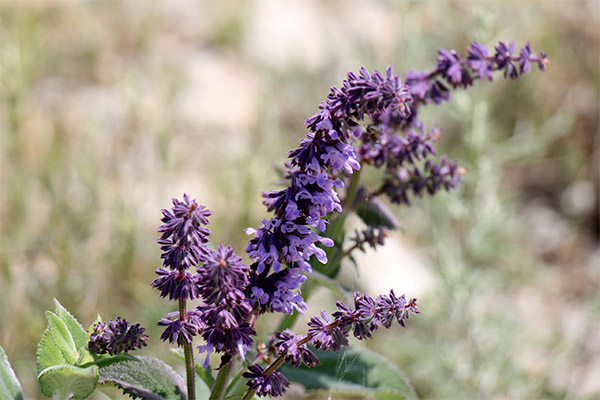
Sage is a real storehouse of healing vitamins and other beneficial substances, which include:
- resin;
- gum;
- starch;
- camphor;
- cineol;
- thujone;
- tuyol;
- salven;
- borneol;
- pinene;
- tannins;
- oleanic, ursolic, chlorogenic, phenolcarboxylic acids;
- vitamin P and PP;
- volatile;
- alkaloids;
- flavonoids.
The list is impressive and gives this type of plant an invaluable gift of healing people from many diseases.
How it looks and where it grows
Sage (salvia) is a perennial bushy plant with purple, lilac-blue and blue inflorescences and fruits in the form of small dark brown nuts. The countries of southeastern Europe and Italy are considered homeland. The height of the shrub can range from 20 to 70 cm. It grows in regions with warm climatic conditions. Currently, sage is grown in Italy, France, Russia, mainly in the Krasnodar Territory, Ukraine, Slovakia, Greece, the Czech Republic and Yugoslavia. A powerful branched root, a straight branched stem, small-boreal along the edge, with a wedge-shaped base, wrinkled leaves, purple inflorescences - all these are the distinguishing features of this plant.
Unfortunately, it does not occur in the wild on the territory of the Russian Federation, but is represented by cultivated or already feral shrubs that feel good in the fields and gardens.
Perennial propagated by seeds and cuttings, which are planted either in late autumn or early spring. Flowers appear in June or July, and fruits can be harvested in August or September. Sage begins to bloom in the second year of its life.
Views
Currently, science has about 900 species of sage. Previously, the number of varieties was equal to two thousand, but, unfortunately, many species have disappeared at the moment. The most famous are considered the following:
- Clary. This wild plant can be found in the southern regions of Europe, in Asian countries, as well as in the Caucasus. Its healing power lies in the essential oil, on the basis of which medicines are made to treat psoriasis.
- The Ethiopian sage variety is found in North America. It is also cultivated in Central Asia, the Caucasus and in the central regions of the Russian Federation. The variety is considered an excellent honey plant. Traditional healers who use plant oil to treat tuberculosis patients appreciate its benefits.
- White or narcotic sage contains salvinorin - a special psychoactive substance. Thanks to this element in the homeland of the variety - Mexico - it is used by sorcerers for ceremonial purposes.In Russia, this species of sage is included in the list of banned plants. In small doses, he is able to cope with headaches, anemia, rheumatism and kidney diseases.
- Steppe sage is a wild species found in Western Siberia and in Kazakhstan. It is mainly used in cosmetology.
- The artificially bred sage variety is called vegetable and is subdivided into several types. It differs from its wild "brothers" by a larger leaf. It is used in cooking.
- Sage meadow or field is common throughout Europe. The main area of its application is cooking.
- Moldavian sage has several names: oak or yailinsky. The variety growing in the Crimea and the Caucasus is a wonderful honey plant, but is not used in medicine.
- The most famous type of sage is medicinal. It is used in all industries and even as an ornamental plant.
When to collect and how to store sage
Healing properties are possessed by flowers and leaves of a plant. They are usually collected in two ways: either manually cut off the leaves and inflorescences, or with the help of a sickle or special scissors cut off the part that is on the surface, and then dry it. Harvesting takes place for the first time one year after sage is sown. The collection season is June, July and September, i.e. when it blooms and bears fruit. It is best to harvest the plant on a dry, sunny day after the dew drops have dried.
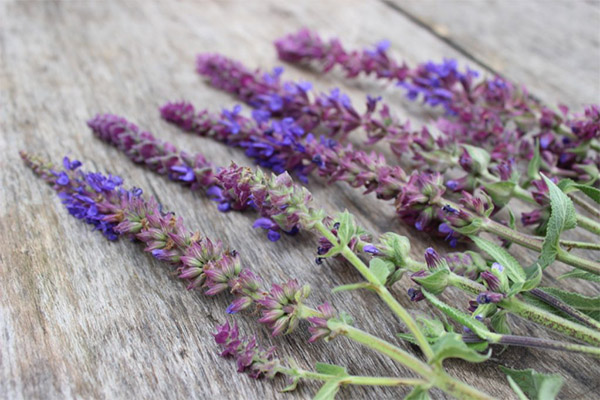
As for storage, there are two options - whole leaves and inflorescences or in crushed form. But it is also worth noting that when using the second method, useful substances and oils evaporate faster, and the plant loses its healing power. For better preservation of useful properties, cardboard boxes, canvas canvas bags, as well as cans with nylon covers are used. The room should be well ventilated. Shelf life can reach two years.
Also, the grass can be frozen. To do this, initially it should be well washed and dried. Then collect the leaves in small bags and put them in the freezer. In this state, the taste of sage takes on an enhanced sound, so for cooking, for example, you need to take a smaller amount than stated in the recipe. You can store a frozen product for one year.
How to dry
In order for sage to be beneficial, it must not only be properly collected, but also dried. To do this, it is washed in running water immediately after collection. Then laid out on paper and dried naturally, but in dark places. It should be noted that when washing leaves and flowers, warm, but in no case hot water should be used, because this will result in the loss of precious oils and minerals. If the plant is dried whole, then it is tied in small bunches and suspended "upside down."
In addition to natural drying, you can use a special dryer or an ordinary oven, but remember that the temperature should be no more than 40 degrees.
The finished product should have a characteristic fragility of leaves and inflorescences.
Useful properties of sage herb
Sage has a lot of useful properties, which ensures the presence of a huge amount of vitamins and minerals in its composition. Specialists distinguish the following areas where the benefits of sage are proved unconditionally:
- external use;
- field of gynecology;
- lower respiratory tract diseases;
- pathology of the urinary system;
- digestion problems;
- disorders of the nervous system;
- the process of losing weight.
Naturally, in each "industry" the plant is used in different variations recommended by the doctor.
For women
Fragile women's health at all times needed additional protection. So, sage has become one of the "protectors" of the body of beautiful ladies. Its benefits for the weaker sex are as follows:
- The ability to improve the condition during menopause.The fact is that the plant has an estrogenic function, which is disturbed during the menopause. The grass also fights well with hot flashes, increased sweating, and also helps to improve memory and relieve nervousness.
- Help in the fight against infertility. All the same estrogenic qualities help fight hormonal infertility. Experts recommend that women use this herb immediately after menstruation and before the moment of ovulation with a low level of estrogen. This will help establish a hormonal background and increase the chances of pregnancy.
- Elimination of female frigidity. And, of course, sage will completely cope with the task, normalizing the hormonal background and restoring sexual desire. To do this, you need to drink a glass a day of a decoction of sage and linden, taken in equal amounts and infused in 250 ml of boiling water. Then there will be no problems with female libido.
- The ability to defeat and destroy cancer cells. This quality is especially valuable for women, because sage helps to cope with cancer of the breast, cervix, and also the skin, intestines, kidneys and oral cavity.
- Elimination of inflammation in the female organs (cervix, vagina).
- The ability to minimize wrinkles. For the beauties of the whole planet, this is a very important quality.
- Help with the treatment of thrush. The herb is used as an aid in douching and helps relieve itching and irritation.
- The ability to normalize the menstrual cycle and eliminate its unpleasant symptoms.
- Stimulation of follicular growth.
- The fight against cystitis. With this disease, it is added to the bathroom and taken orally.
For men
Sage is a generous herb; therefore, it not only shared its care with women, but also did not disregard the stronger sex. The use of plants is indicated in such cases:
- increased testosterone production;
- improvement of blood circulation and regulation of metabolism;
- elimination of stagnation from the ejaculatory ducts;
- normalization of the prostate gland;
- increased potency;
- increased sexual desire;
- prevention of genital diseases;
- increased action of drugs aimed at conception.
Men, like women, can take herbal medicine in the form of infusions, tinctures, decoctions, and juice.
During pregnancy
In ancient Rome and ancient Greece, where the name came from, sage was translated as "to be healthy." The healers respected and appreciated this plant. But pregnant women at all times were strictly forbidden to take grass during the period of bearing the baby. If other plants can be consumed in small doses, then sage can not be! This poses a real risk of miscarriage, as the plant is able to contract the uterus.
The only way to use the decoction is to gargle or for lotions with varicose veins. In other cases, sage is strictly prohibited!
For children
Most mothers with the diseases of their children try to find an alternative to medicines in traditional medicine and natural healing products and plants. If we talk about the use of sage in the fight against childhood diseases, then it is able to cope with tonsillitis, and with tonsillitis, and nervous disorders, but only taking it up to five years is not recommended. From five you can already resort to the healing power of the grass, but only after the permission of the pediatrician.
When breastfeeding
In fact, nursing mothers, like pregnant women, are not allowed to take sage, as it reduces lactation. Therefore, it can be used only with increased lactation, to reduce the amount of breast milk, and at the end of breastfeeding. In the latter case, 50 ml of herbal decoction should be taken in equal portions four times a day, fifteen minutes before eating. Experts say that with this use, lactation ends smoothly after 2-3 weeks. In addition, it does no harm to the body of a woman.
When losing weight
Having a desire to lose weight, a person subconsciously hopes for a quick result and the presence of some kind of magic remedy that helps to achieve the desired volume with lightning speed. Of course, sage will not eat nasty kilograms, but it’s quite capable of coping with some of the problems that await the body on a diet. Namely:
- saturation with additional vitamins and minerals;
- body cleansing;
- restoration of the immune system;
- improving the taste of diet foods;
- prevention of skin aging due to a large number of antioxidants;
- help in the fight against cellulite by stimulating the production of estrogen;
- normalization of the gastrointestinal tract;
- prevention of edema.
To solve all these problems, sage is used as a decoction, added to baths or used in wraps to help significantly narrow the shape.
Sage in medicine
From ancient times, traditional healers, healers and sorcerers searched for miraculous remedies for the treatment of various diseases based on components of natural origin: roots, flowers, fruits and herbs. Everything went for the manufacture of drugs. The discovery was sage, able to cope with numerous ailments. At present, both the scientific community, which has studied the properties of herbs, and doctors have recognized the benefits and introduced sage in the medical industry.
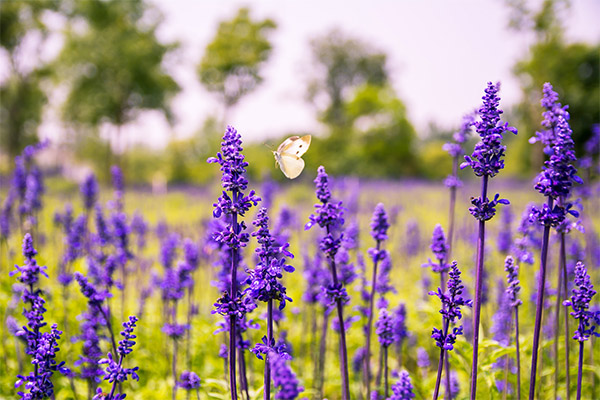
Experts have concluded that the plant has a positive effect in the following diseases:
- stomatitis;
- gingivitis;
- angina;
- pharyngitis;
- conjunctivitis;
- pleurisy;
- tuberculosis;
- bronchial asthma;
- depression and sleep disturbances;
- paralysis;
- disorders of the nervous system;
- gastritis;
- colitis and gastric ulcer;
- diabetes;
- bowel disease;
- diarrhea;
- gallbladder disease;
- toothache;
- low blood pressure;
- atherosclerosis;
- anemia;
- pain in the heart;
- impaired memory and concentration;
- infertility;
- menopause;
- menstrual irregularities;
- metabolic problems;
- excess weight;
- radiculitis;
- polyarthritis;
- hemorrhoids;
- prostate diseases;
- suppuration;
- soft tissue bruises.
Note: some diseases require special attention.
With diabetes
For patients with such a diagnosis, the plant can do a great job in lowering blood sugar levels. It's all about the ability of the herb to stimulate the production of insulin. As a rule, sage is used for a mild form of the disease. Doctors recommend using it in combination with other herbs that are useful for patients with diabetes, such as dandelion or goat. But before use, consultation with a doctor will help determine the daily dose, as well as the most effective composition of the drug.
With gastritis
In the twenty-first century, the number of patients with gastritis is growing steadily, so doctors are looking for the most effective methods of combating the disease, not only with medications, but also with alternative methods. Sage herb is considered to be a good helper in the fight for a healthy stomach. It can be used as a natural antiseptic and anti-inflammatory agent. Tannins and vitamin PP help to strengthen the epithelium of the stomach, and salvin contained in the plant prevents the reproduction of Helicobacterpilori. In addition, the plant copes with flatulence. For best results, doctors advise taking a decoction 20-30 minutes before a meal before each meal.
With menopause
The symptoms of menopause are familiar to many women firsthand. Headache, irritability, endless tides - all this “bouquet” of ladies have to face during menopause. And with all these symptoms, sage herb does a great job. It normalizes the hormonal background of a woman, reduces the number of hot flashes, and also helps to get rid of nervous excitement and insomnia. In these cases, it is better to take teas and decoctions of herbs.To prepare them, you need to pour one tablespoon of grass with boiling water and let it brew for one hour. Such a tool is used up to five times a day for a month, and then take a break for two weeks. It is better if the broth and infusion is taken 40 minutes before meals.
You can use sage juice, consuming it two tablespoons a day. The course of treatment is two weeks. But before using these funds, you must definitely visit a doctor to get advice on the possibility of taking sage, as when used together with hormonal drugs, serious complications can occur.
For the kidneys
People with kidney disease can also take advantage of the miraculous power of sage. The fact is that grass has an excellent diuretic property and can help. It is also a good diaphoretic, which is important for patients with kidney problems. To improve the condition and eliminate symptoms, patients are recommended decoctions and infusions. In this case, preference should be given to multicomponent collections, where along with sage will be present, for example, birch leaves, bearberry, rosehip berries, juniper, etc. But they can not be treated with acute inflammation of this organ. It is in order to assess the benefits and achieve a speedy recovery, it is necessary to consult your doctor who will prescribe the recommended dose depending on the specific diagnosis and based on the individual characteristics of the person.
With colitis
Sage copes with bowel diseases by preventing the harmful effects of stomach acid on the inflamed walls. Experts recommend adding centaury and chamomile flowers to it. In this composition, sage will be most active and will cope with the task faster. To prepare the broth, you need one tablespoon of the plant and 250 ml of hot water. Insist for two hours and consume one tablespoon every two hours. Sage does not have any negative consequences for patients with a diagnosis of "colitis", so the duration of treatment can be quite long.
With cystitis
Cystitis is a disease that they don’t want to talk about, but it can deliver a lot of unpleasant moments. That is why I want to deal with it as soon as possible. Sage herb will help quickly and effectively defeat a "nasty" disease without harmful effects on the body. Due to its antiseptic, anti-inflammatory, disinfecting properties, the plant has become a wonderful tool in the fight against cystitis. It is recommended to use the classic recipe for herb infusion (20 g per 250 ml of boiling water), warm over low heat for 30 minutes and take 50 ml three times a day before meals. Also very effective are the baths with the addition of the infusion of the plant.
With pancreatitis
The pancreas requires particularly close attention during an exacerbation. It is very important to take herbal decoctions, which help relieve inflammation. Sage is part of the main composition of such collections as an anti-inflammatory agent that can relieve pancreatic irritation, have a preventive and disinfecting effect. The only undesirable type of use of sage in such diseases is alcohol tinctures, which can only worsen the condition of the patient. Infusions should be prepared according to the classic recipe and taken 30 minutes before meals for three months, then take a break for 5 weeks. Such treatment will have a calming and preventive effect on the pancreas.
From hemorrhoids
People suffering from varicose veins of the large intestine should seek help from sage. It is able to relieve pain, inflammation, have a disinfecting effect, and also prevent re-inflammation. It is customary to do baths, microclysters and compresses to combat this disease. Also, the use of a decoction of the plant normalizes the intestines and eliminates constipation, which is so important for hemorrhoids. Compresses and lotions should be applied to the sore spot for 15 minutes several times a day.
From worms
The plant has an antiparasitic effect, which is relevant in the fight against helminths. When citrus wormwood is added to the grass, a very powerful anti-worm remedy is obtained. For such a drug, you need to pour 4 tablespoons of the collection with one liter of boiling water. Such a composition should be left to stand overnight, and in the morning honey should be added to it (already filtered). This remedy is consumed throughout the day, and then resorted to using castor oil, which you need to drink in the amount of two tablespoons, and birch tar. It needs to be poured on a fleece and tied in the navel. In the morning, the parasites will leave.
Against cough
Due to its expectorant property, sage is an effective treatment for lower respiratory tract diseases. It improves the process of discharge of sputum, contributes to the destruction of pathogenic bacteria, eliminates inflammation of the respiratory tract as a whole.
One of the popular cough suppressants is sage with milk. To do this, you need to combine two teaspoons of grass with warm milk, while the more fat content, the better. Bring the mixture to a boil, strain, boil again and use as an antitussive drug.
With infertility
Help with hormonal infertility will help all the same sage. It includes phytoestrogen, which contributes to the development of the female egg and thereby increases the chances of a faster conception. It is necessary to use the plant on the recommendation of a doctor who will prescribe a herbal treatment regimen, a method and determine the allowable dosage in each case. It is with this diagnosis that we need accurate recommendations and the norm prescribed by a specialist, and not by a miraculously healed neighbor!
With angina
Due to the presence in its "composition" of various trace elements and vitamins, sage has a bactericidal, astringent, antiseptic and anti-inflammatory effect. It is also one of the natural antibiotics, so its use during treatment of angina is not only considered possible, but also necessary. With the help of plants, they gargle, make inhalations, and also are taken orally. Such methods of treatment will quickly relieve pain, eliminate irritation and raise the general tone of the body.
With a cold
In a season of increased spread of acute respiratory infections, doctors advise taking tinctures and decoctions from sage, as they are able to increase the body's resistance against colds, cope with a cough, soothe a sore throat, and destroy pathogenic bacteria. In addition, candies and lozenges with the addition of this plant will be useful. A tea with grass drunk at night will help calm down, fall asleep and wake up a completely healthy person.
With perspiration
Sage will help eliminate hyperhidrosis (increased sweating). Baths and infusions with it contribute to the normalization of the functioning of the sebaceous glands, reduce the amount of sweat and help get rid of unpleasant odors.
For the preparation of baths, a shredded plant is used in the amount of one glass per five liters of water. This “potion” should stand 24 hours before it is added to the bathroom, the duration of which is 20 minutes. This method is suitable for daily use and perfectly fights with this problem.
With endometriosis
Sage is indicated for many diseases, but with endometriosis, its use is prohibited, because grass has the ability to increase estrogen growth, which, in turn, can provoke the development of a benign formation.
With flux
Diseases of the oral cavity are included in the list of pathologies that magic grass can cope with. Firstly, it disinfects, and secondly, it draws out pus and reduces the inflammatory process.To rinse, dentists advise using an alcohol solution. It is added in the amount of thirty or forty drops per one glass of water.
With sinusitis
In the treatment of a disease such as sinusitis, you can use sage, or rather a solution based on it for washing the nose. The solution is prepared as a regular infusion, i.e. take 1 cup of water for 1 teaspoon. Insist an hour and start the procedure. The plant copes well with the disease, because fights microbes and prevents the virus from spreading.
Types of medicinal compounds with sage
Ancient physicians, such as Hippocrates, used to make decoctions, infusions, and aromatic baths from the "sacred grass," as ancient physicians called sage. Since then, the recipes have been improved, but the methods of using the plant have not changed. Currently, sage is used as all the same decoctions, infusions, teas, and tinctures. In addition, at the moment there are lozenges or tablets with sage, which are prescribed in the treatment of tonsillitis, tracheitis, bronchitis, etc. Also, dry plant powder, which is a crushed part of the plant, was widely used. All kinds of liquid preparations are prepared on its basis. So what are their features?
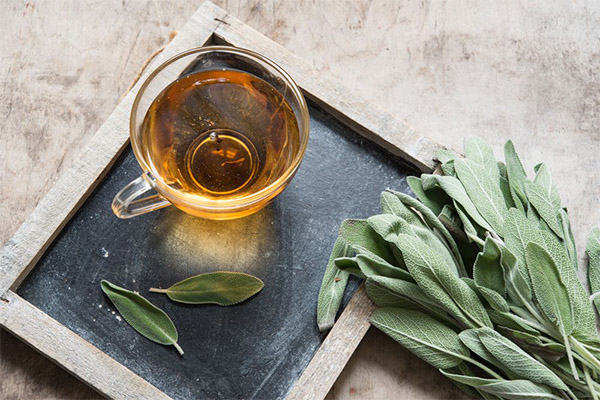
Infusion
The infusion is considered to be the liquid form of the drug, which is an extract from plant material. Infusions can be used internally, externally or as inhalations. The word itself means the process of insisting.
Infusions from sage are taken as a choleretic agent, to combat flatulence, improve the digestive tract, etc.
To prepare the infusion, you need hot water and, in fact, the leaves or flowers of the plant. Usually they are taken in a proportion of 1:10 or two tablespoons per glass of boiling water and taken 20-40 minutes before meals. You can also prepare an infusion in a water bath, but you can not allow the product to boil. It is taken in diluted form in a ratio of 1: 4. To preserve the essential oils, prepare the infusion of this herb should be in a tightly sealed container.
Tincture
Tincture is a mixture of alcohol-containing liquid with various herbs (in the case of herbal tincture). Sage tinctures is a greenish-brown liquid infused with 70 percent alcohol in a ratio of 1:10.
To prepare tinctures at home, take half a liter of vodka and mix with three tablespoons of sage. All this is poured into a bottle, corked and left for 28 days, after which it is filtered and poured into a clean bowl. Specialists advise taking tincture solely on the recommendation of a doctor.
Decoction
Decoctions, like infusions, are a liquid dosage form of a vegetable extract. For external use, decoctions are prepared in a ratio of 1: 5, and for internal use - 1:10.
To prepare a decoction of sage, two tablespoons of dried leaves and 200 ml of boiling water are required. All this is cooked in a water bath for fifteen minutes. Then cool slightly, filter and add so much boiling water to get the original volume. The broth should be stored in the refrigerator for no more than two days.
Tea
What is tea, everyone knows. They are different, including herbal. Sage tea is unique in its beneficial properties, so it is drunk not only for pleasure, but also as a medicine. It boosts immunity, fights colds and soothes nerves, and also stimulates the digestive tract, helps with fever and headache, and removes toxins.
It is prepared almost in the same way as the infusion (one teaspoon per glass of boiling water), but they are drunk immediately after preparation in hot form. It is very convenient to use pharmacy bags with sage. Fast and helpful!
Sage oil: properties and applications
Sage oil is considered one of the most valuable varieties of essential oils. Its second name is nutmeg. It gained its greatest distribution in the field of aromatherapy and cosmetology. The oil has anti-inflammatory, antibacterial, antispasmodic and sedative properties. In total, there are more than 20 useful compounds, but the most valuable substances are:
- alkaloids;
- terpenoids;
- flavonoids;
- salvin;
- linoleic acid.
Thanks to them, oil is used for the following purposes:
- treatment of inflammation of the oral cavity, skin diseases, bruises;
- stress relief of the vocal cords and nerves;
- memory improvement;
- stimulation of brain activity;
- increased concentration of attention and immunity;
- treatment of infectious diseases;
- headache elimination.
This product is used for external use and, as a rule, is added to the main component. Most often, oil is used for inhalation, various lotions, compresses and baths.
With all its beneficial effects, experts do not recommend the use of such a tool:
- with individual intolerance;
- during pregnancy;
- with epilepsy;
- with problems associated with blood pressure;
- in children under 2 years old;
- when drinking alcohol.
In any case, before you start using the oily product, you must study the contraindications, instructions and methods of use, as well as consult with a competent doctor.
Application in cosmetology
Sage is able to slow down the aging process, fight wrinkles, take care of hair, and strengthen nails. For all these qualities, the miraculous oil was recognized by capricious beauties and cosmetologists.
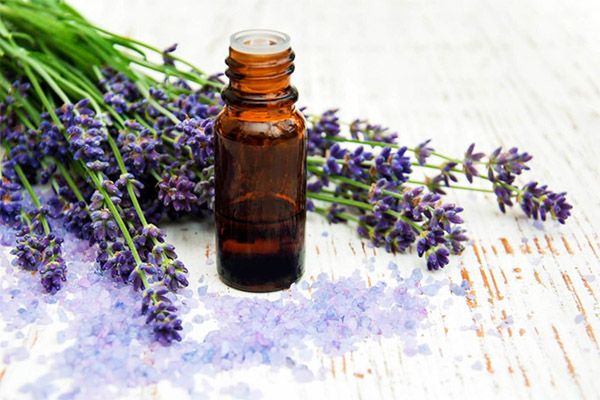
For face
Since oil is an anti-inflammatory and antimicrobial agent, it was immediately adopted by specialists in the field of beauty industry and began to be used in the treatment of various skin rashes. But you need to do this very carefully, because there is a chance of worsening, not improving, the situation. Ether is most suitable for oily and problematic skin. It is also worth remembering that in its pure form, application to the skin of the face is strictly prohibited due to the possible risk of burns or inflammation. It is best to use it for making masks.
For oily skin
Ingredients:
- apple - 1 pc.;
- lemon juice - 5 ml .;
- sage oil - 5 drops;
- rosemary oil - 5 drops.
The baked apple should be peeled and mashed to a mushy state. Add lemon juice and oil. Mix everything thoroughly. Apply the mask to the face, except for the eye area, for twenty minutes, after which wash with warm water.
To restore elasticity
Ingredients:
- jojoba oil - 5 ml;
- sage oil - 2 drops.
This composition should be applied to clean skin for 20 minutes, and blot excesses with a cosmetic towel.
To restore tone
Ingredients:
- base oil (any) - 2 tbsp .;
- lemon oil - 2 drops;
- sage oil - 2 drops;
- chamomile oil - 2 drops;
- lavender oil - 2 drops.
Mix the components and apply to the skin.
Anti-aging mask
Ingredients:
- honey - 1 tsp;
- natural yogurt - 1 tsp;
- oat flour - 0.5 tsp;
- sage oil - 3 drops.
Mix all ingredients and apply on face and neck for 20 minutes. After rinse with warm water. The procedure is advised to be performed no more than twice a week.
Having tried such masks, women note an improvement in the appearance of the skin of the face, the elimination of inflammation, and, as a result, the appearance of a good mood!
For hair
Hair is the beauty and wisdom of a woman. That is what our ancestors thought. Yes, and men thick hair to face. To make your hair luxurious, like TV divs advertising shampoos, you can use sage essential oil, which can relieve dandruff, normalize the sebaceous glands, eliminate irritation, and strengthen hair follicles. To prepare hair masks, warm the essential oils to a temperature of 40 degrees. The compositions are recommended to be applied to wet hair and do not use a hairdryer after shampooing. Also, the mixtures should be freshly prepared, as their storage is not allowed. Here are some miraculous recipes.
For dandruff
Ingredients:
- cream - 3 tbsp;
- salt - 1 tsp;
- sugar - 1 tsp;
- sage oil - 5 drops.
Apply this composition as a mask on the head for 20 minutes, and then wash your hair with shampoo.
For healthy hair
Ingredients:
- burdock oil - 30 ml;
- sage oil - 4 drops.
The product is applied to the scalp and the entire length of the hair. Then put on a hat and wrap a towel for one hour. After head rinse with shampoo.
Against fragility
Ingredients:
- yogurt - 2 tbsp .;
- yolk - 4 pcs.;
- sage oil - 5 drops.
Apply the mixture along the entire length of the hair and rinse with shampoo after one hour.
For hair growth
Ingredients:
- almond oil (olive oil is possible) - 3 tbsp;
- sage oil - 6 drops.
Apply this product along the entire length of the hair and cover your head with a towel. Hold for 30 minutes.
Against baldness
Ingredients:
- dry sage leaves - 5 tbsp;
- rosemary - 5 tbsp;
- nettle leaf - 10 tbsp;
- vodka - 500 ml;
- apple cider vinegar - 500 ml.
At the first stage, mix all herbal ingredients with vodka and vinegar, and then store in the cold for 2 weeks in a ceramic bowl. During the specified time, the mixture should be stirred and shaken. After the period of sedimentation, the product must be filtered through a dense gauze layer. The tool is recommended to be applied to the hair roots and massage the scalp. People with a normal type need to wash off the composition after one hour, and for those who have oily hair, you can leave the drug overnight. Rinse with clean, warm water. The course of such procedures lasts 10 days, however, this method should be applied in a day.
For skin of hands and nails
Hands and nails need additional protection. Women use various creams and firming compounds to prolong the youth of the skin of the hands and strengthen the nails. But it is not necessary to purchase expensive funds. It is enough to use sage essential oil and at home get an excellent antibacterial and firming agent.
Hand bath
Ingredients:
- warm milk - 0.5 l .;
- sea salt - 1 tsp;
- sage oil - 3 drops;
- geranium oil - 3 drops;
- cedar oil - 3 drops.
Such a bath should be done once a week and the skin of the hands will become moisturized, smoothed out, and the nails will become strong.
Against fragility of nails:
Ingredients:
- warm milk - 0.5 l .;
- sea salt - 2 tsp;
- soda - 0.5 tsp;
- honey - 0.5 tsp;
- iodine - 0.5 tsp;
- sage oil - 2 drops.
The bath also needs to be done once a week, and the nails will cease to exfoliate and gain strength.
The use of sage in cooking
The useful properties of sage are used not only by doctors and cosmetologists, but also by culinary experts from around the world. Grass can saturate dishes with vitamins and minerals, as well as give familiar recipes an unusual sound. Sage frozen in ice cubes can be added to ready-made snacks to give them an exquisite flavor. The taste of the plant is islandy, and the aroma is spicy, so it is used for the preparation of meat, fish dishes, salads and pastries. The best seasoning, combined with sage, is considered to be onion, garlic and laurel. It is mainly used at the end of cooking.
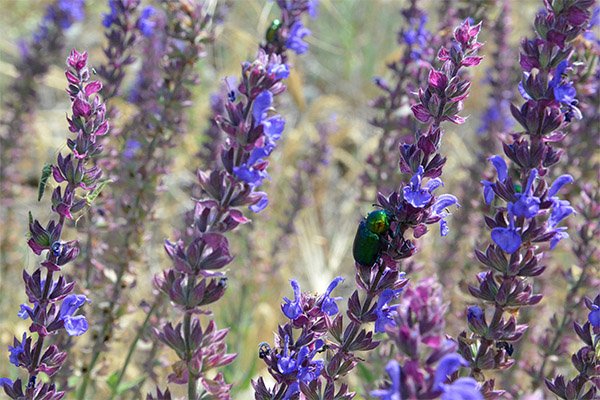
Confectionery, distillery, canning industry, as well as cheese making - in all these sectors of the American continent, sage has become widespread. Most often it is used to prepare the following dishes:
- homemade sausages;
- poultry meat;
- beans;
- pork on fire;
- mutton;
- tomato sauce;
- egg dishes;
- fish;
- tea.
Sage is used to create unique shades of taste and aroma that can bring not only pleasure from food, but also health benefits.
Contraindications
Amazing sage is so unique and in demand that it is hard to believe in its negative influence. However, there are a number of contraindications when the use of this plant is contraindicated:
- allergy;
- pregnancy;
- lactation period;
- endometriosis;
- epilepsy;
- risk of addiction;
- children under 2 years old;
- hypotension;
- exacerbation of diseases of the urinary system;
- oncology;
- elevated estrogen levels;
- thyroid disease;
- bronchial asthma.
These are the main factors of the negative impact of miracle grass. If a person has no contraindications for its use, then it is worth turning to sage, which can cure many diseases by the natural force of nature!
«Important: all information on the site is provided exclusively in fact-finding purposes. Before applying any recommendations, consult with a profile specialist. Neither the editors nor the authors are liable for any possible harm caused materials. "

